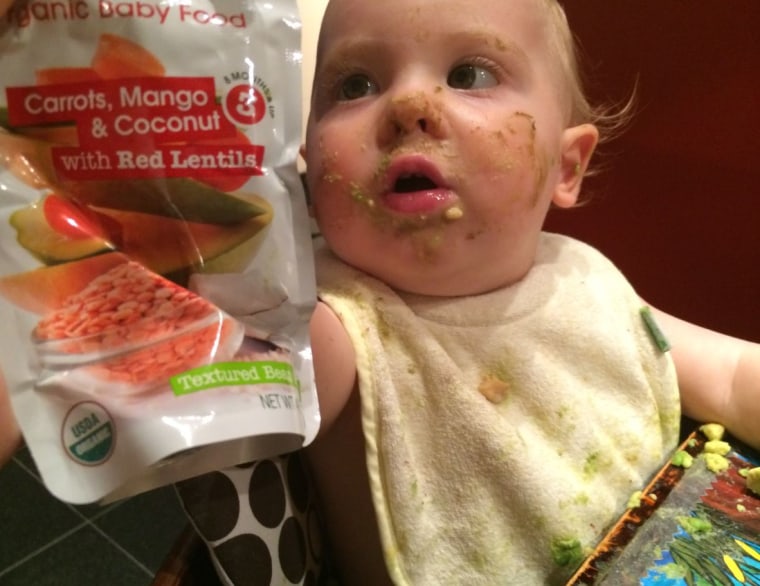Organic barley, kale and spinach with basil. Wild Alaska salmon with quinoa, corn and peas. Chickpea and tomato with beef and cumin. No, these aren’t dishes off the buffet at Whole Foods—these are modern-day baby foods.
They also represent the one segment of the baby food market that is thriving—organics. Fed up with unappetizing jars of light-tan and pale-green purees, today’s generation of moms leans heavily on homemade baby foods—taking a chunk out of profits for the baby food industry, where unit sales have decreased since 2005. But new companies are luring moms back—and driving up sales of baby food, dollar-wise—with creative mish-mashes that adults would happily eat.
And there’s definitely a backlash going on against the guilt of feeling like parents need to make their kids’ own baby food. Sarah Jean Baptiste, an organic-conscience mother of two in Oregon, buys her baby food, she says, because she loves the variety of nutrients she can offer her baby—variety she could not otherwise pull off working 40 to 50 hours a week.
“I applaud women who have the time to make their own organic quinoa, kale and pomegranate purees, but I am just not one of those ladies, and for that I am grateful for my pouches of baby goodness.”
Organic baby food product sales are on the rise, confirms Helen Bernstein, vice president of marketing and special projects at Happy Family (which makes the salmon dish mentioned above).
Natural supermarkets reported a 63 percent increase in organic baby food sales from 2011 to 2013, according to Mintel and SPINS research. It’s also predicted that, with the recovering economy and birthrates, more parents will be willing to buy baby food versus making their own—Mintel predicts baby food and snack sales to grow 30 percent from 2012 to 2017, to reach $2.2 billion.
And organics are just the beginning, Bernstein adds, noting Happy Family offers loads of nutrient-rich superfoods—like a ratatouille made with amaranth, veggies and quinoa—or a kale, apple and mango blend with Salba, the super chia. “Moms want to introduce their little ones palates to a variety of tastes and textures,” she said.
Plum Organics (maker of the cumin-chickpea and barley-basil products) claims its place as the first in the industry to introduce unique, trendy ingredients and culinary-inspired creations. “We believe little ones should have the opportunity to explore a wide variety of flavors, colors, textures, and superfoods,” Neil Grimmer, co-founder and president, told TODAY.com.
Some of Plum’s most popular varieties include “sophisticated flavor pairings like blueberry, pear and purple carrot, and raspberry, spinach and Greek yogurt, as well as superfoods like quinoa, kale and amaranth,” he noted. “We want babies to eat the very best food from the very first bite to inspire a lifetime of healthy eating."
So do the products live up to the hype, compared to what you can make at home? “They’re nutritious, but not necessary. I’m not against them, but you’re paying a lot extra for marketing and packaging,” said Connie Evers, MS, RD, a pediatric dietitian and founder of NutritionforKids.com.
The important thing, she says, is getting kids to eat whole foods like fruits, grains, vegetables, and it can be as easy as parents mashing up a sweet potato alongside their own dinner. “The whole concept of superfoods is a little overblown. All plants and vegetables contribute phytochemicals that are beneficial,” she said.
To use foil pouches wisely, Evers also recommends pouring the baby food into bowls, unless you’re traveling or on the go. “Pouches can really interfere with feeding development—they should be learning how to finger-feed and use a spoon.”
She also cautions against always feeding youngsters fruit-veggie combos. “Because what happens when they’ve always been eating ‘broccoli-blueberry,’ and now it’s just ‘broccoli’?” she jokes (that’s not a real combo...that we know of, anyway).
(Bernstein notes, “The mix of fruit and vegetables is appealing to kids who have a natural sweet tooth. Even breastmilk is somewhat sweet.”)
Evers does applaud the industry’s move toward adventurous flavor combos, though: “Americans tend to stick to such bland baby foods. In India, they feed babies curry. In Mexico, they feed babies chilies and garlic,” she said. “It’s all palate-building.” Just avoid added sugars and sodium, she warned.
But let’s face it: For moms, at the end of the day, most choices about baby food come down to time and money.
Liz Thompson, a mother of three in upstate New York, mainly made her own food for cost reasons—especially veggies like sweet potatoes, peas and carrots. For travel and for certain fruits and veggie purees, she’d buy store-bought, usually the brands on sale. “If we had to do it again, I don’t think I would change anything,” she says. “As far as superfoods and interesting flavors go, I think children will eat whatever they see their parents eating.”
